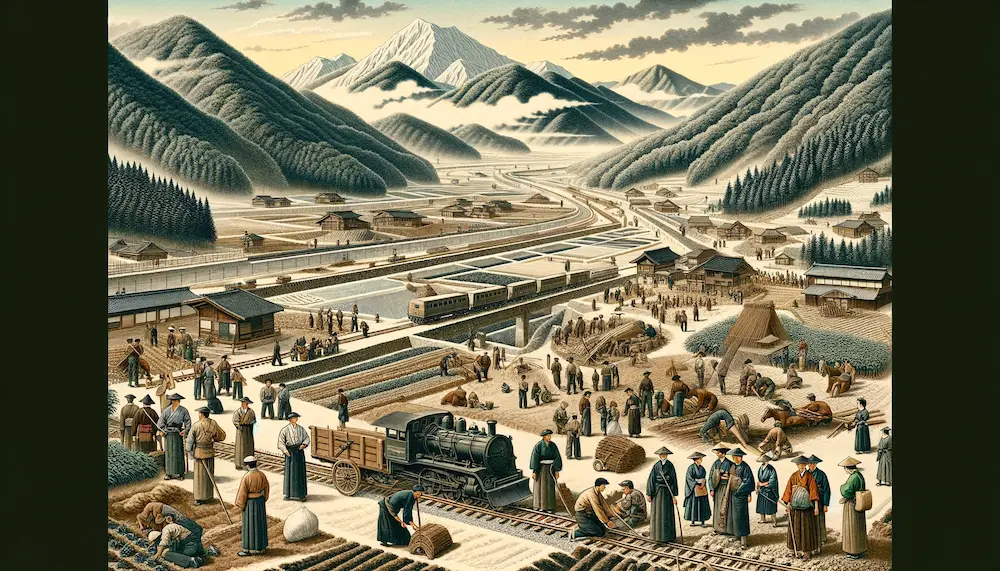Hokkaido’s Development During the Meiji Restoration
The Meiji Restoration, which began in 1868, marked a period of profound transformation in Japan. It ushered in an era of modernization and westernization, fundamentally changing the country’s social, economic, and political landscapes. Hokkaido, Japan’s northernmost island, played a crucial role during this period as the Japanese government sought to develop and integrate it into the nation. This article explores the reorganization and development of Hokkaido by the Meiji government, the establishment and role of the Hokkaido Development Commission (Kaitakushi), and the significant infrastructure and immigration policies implemented during this transformative era.
Reorganization and Development of Hokkaido by the Meiji Government
The Meiji government’s vision for Hokkaido was ambitious and multifaceted. Recognizing the strategic and economic potential of the island, the government aimed to develop Hokkaido as a bastion of modern agriculture, industry, and defense. The policies and strategies implemented during this period were designed to transform the largely undeveloped and sparsely populated island into a thriving part of the nation.
Key figures in this reorganization included Kuroda Kiyotaka, who played a significant role in the development of Hokkaido. He was instrumental in establishing the Kaitakushi and implementing various development projects. The government’s approach was characterized by a blend of Western techniques and Japanese innovation, aiming to create a modern infrastructure and promote economic self-sufficiency.
The reorganization of Hokkaido involved extensive land surveys and the establishment of a land tenure system that facilitated the distribution of land to settlers. These measures were crucial in encouraging migration and settlement, which were central to the development plans.
Establishment and Role of the Hokkaido Development Commission
In 1869, the Meiji government established the Hokkaido Development Commission, known as the Kaitakushi, to oversee the island’s development. The Kaitakushi was tasked with a wide range of responsibilities, from land surveys and infrastructure development to promoting immigration and agricultural innovation.
The Kaitakushi’s objectives were ambitious. They aimed to transform Hokkaido into a center of modern agriculture by introducing Western farming techniques and crops. Additionally, they sought to exploit the island’s natural resources, including its forests and minerals, to support Japan’s burgeoning industrialization.
One of the major initiatives undertaken by the Kaitakushi was the establishment of experimental farms and agricultural stations. These facilities served as centers for research and education, helping to introduce and disseminate new farming methods. The Kaitakushi also invested in infrastructure projects, such as the construction of roads, ports, and railways, to improve transportation and facilitate the movement of goods and people.
Infrastructure Development and Immigration Policies
Infrastructure development was a cornerstone of the Meiji government’s efforts in Hokkaido. The construction of roads, railways, and ports was critical in linking the island to the rest of Japan and supporting its economic development. Notable projects included the establishment of the Horonai Coal Mine and the construction of the Horonai Railway, which were instrumental in developing the island’s industrial base.
Agricultural development was another key focus. The Kaitakushi promoted the cultivation of crops such as wheat, potatoes, and sugar beets, which were well-suited to Hokkaido’s climate. Land reclamation projects converted vast tracts of wilderness into arable land, supporting the growing population of settlers.
Immigration policies played a vital role in Hokkaido’s development. The Meiji government encouraged migration from other parts of Japan, offering incentives such as land grants and financial support to settlers. These pioneers, known as tondenhei (military settlers), were often former samurai and their families, who were given land to farm and were expected to help defend the region.
The impact of these policies on local communities and the indigenous Ainu population was profound. While the development brought economic opportunities and modernization, it also led to significant disruptions. The traditional way of life of the Ainu was increasingly marginalized, and many were forced to adapt to the new social and economic realities imposed by the settlers and the government.
Conclusion
The Meiji Restoration was a transformative period for Hokkaido, reshaping it from a remote frontier into a vital part of modern Japan. The efforts of the Meiji government and the Kaitakushi in reorganizing and developing the island laid the foundation for its future growth and integration into the nation. The infrastructure development and immigration policies not only facilitated economic expansion but also brought profound changes to the social fabric of Hokkaido.
The legacy of the Meiji Restoration in Hokkaido is evident in its modern infrastructure, diverse agricultural practices, and vibrant communities. Understanding this history provides valuable insights into the region’s development and the enduring impact of this pivotal era.
Next:Hokkaido in the 20th Century: From War to Modern Tourism and Economic Growth









